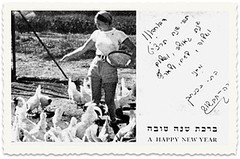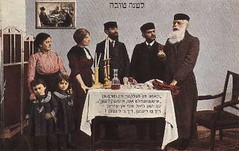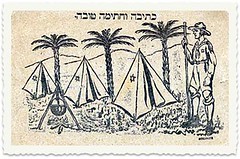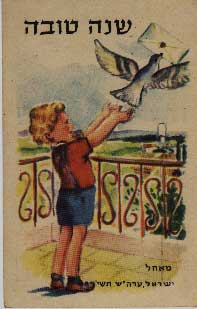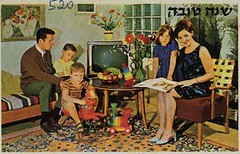Shana Tova - Happy New Year
Published: Mon, 09/26/11
| Shana Tova - Happy New Year | ||||||||
|
| ||||||||
|
Bluenoemi's Specials #4 In This Issue...Shana Tova to all our friends Shana Tova The Jewish New Year Coupon : "shana-tova1" - for 10% discount at Bluenoemi site. Yom Hakipurim About the Pomegranate
   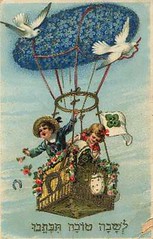 Le Shana Tova
Soon is the beginning of a new year according to the Jewish calendar. Everyone is greeting each other here with "Shana Tova" - May you have a good year or plainly saying: "Hag Sameah" - Happy holiday -Say Shana Tova to everyone you speak to.
Rosh HaShanah is the Jewish New Year. It falls once a year during the month of Tishrei and occurs ten days before Yom Kippur. Together, Rosh HaShanah and Yom Kippur are known as the Yamim Nora'im, which means the Days of Awe in Hebrew. In English they are often referred to as the High Holy Days.
The Meaning of Rosh HaShanah
Rosh HaShanah literally means "Head of the Year" in Hebrew. It falls in the month of Tishrei, that is believed to be the month in which God created the world. Hence, another way to think about Rosh HaShanah is as the birthday of the world.
Rosh HaShanah is observed on the first two days of Tishrei. Jewish tradition teaches that during the High Holy Days God decides who will live and who will die during the coming year. As a result, during Rosh HaShanah and Yom Kippur (and in the days leading up to them) Jews embark upon the serious task of examining their lives and repenting for any wrongs they have committed during the previous year. This process of repentance is called teshuvah. Jews are encouraged to make amends with anyone they have wronged and to make plans for improving during the coming year. In this way, Rosh HaShanah is all about making peace in the community and striving to be a better person.
Even though the theme of Rosh HaShanah is life and death, it is a holiday filled with hope for the New Year. Jews believe that God is compassionate and just, and that God will accept their prayers for forgiveness.
Rosh Hashana Customs and SymbolsOn Rosh HaShanah it is customary to greet people with "L'Shanah Tovah," which is Hebrew that is usually translated as "For a Good Year" or "May you have a good year." Some people also say "L'shana tovah tikatev v'etahetem," which means "May you be inscribed and sealed for a good year." (If said to a woman the greeting would be: "L'shanah tovah tikatevi v'tahetemi").This greeting refers to the belief that a person's fate for the coming year is decided during the High Holy Days.
The shofar is an important symbol of Rosh HaShanah. It is an instrument often made of a ram's horn and is blown one hundred times during each of the two days of Rosh HaShanah.
The sound of the shofar blast reminds people of the importance of reflection during this important holiday. Learn more about the shofar in this article.
Tashlich is a ceremony that usually takes place during the first day of Rosh HaShanah. "Tashlich" literally means "casting off" and involves symbolically casting off the sins of the previous year by tossing pieces of bread or another food into a body of flowing water. Learn more about tashlich in this article.
Symbolic foodsRosh Hashanah meals usually include apples and honey, to symbolize a sweet new year.Various other foods with a symbolic meaning may be served, depending on local minhag ("custom"), such as cooked tongue or other meat from the head of an animal or fish (to symbolize the "head" of the year).
Foods consumed with the Yehi Ratzons vary depending on the community. Some of the symbolic foods eaten are dates, black-eyed beans, leek, spinach and gourd, all of which are mentioned in the Talmud.
Pomegranates are used in many traditions, to symbolize being fruitful like the pomegranate with its many seeds.
The use of apples and honey, symbolizing a sweet year, is a late medieval Ashkenazi addition, though it is now almost universally accepted.
Typically, round challah bread is served, to symbolize the cycle of the year. Gefilte fish and Lekach are commonly served by Ashkenazic Jews on this holiday.
On the second night, new fruits are served to warrant inclusion of the shehecheyanu blessing, the saying of which would otherwise be doubtful (as the second day is part of the "long day" mentioned above).
Other symbolic foods are eaten in a special Rosh Hashanah Seder, particularly in the Sephardic and Mizrahi communities.
Symbolic foods are eaten in a ceremony called the Yehi Rasones or Yehi Ratzones.
Yehi Ratzon means "May it be Your will", and is the name of the ceremony because it is traditional to eat foods symbolic of a good year and to recite a short prayer beginning with the Hebrew words "Yehi Ratson" ("May it be Your will") over each one, with the name of the food in Hebrew or Aramaic often presenting a play on words or pun in Hebrew or Aramaic. The foods eaten at this time have thus become known as "yehi ratsones".
Typical foods, often served on a large platter called a Yehi Ratson platter, eaten by modern Sephardic Jews include apples dipped in honey, or baked or sometimes in the form of a compote called mansanada; dates; pomegranates, or black eyed peas; pumpkin in the form of savory pumpkin-filled pastries called rodanchas; leeks in the form of fritters called keftedes de prasa; beets usually baked and peeled; and the head of a fish: usually a fish course with a whole fish, head intact. It is also common to symbolize a year filled with blessings by eating foods with stuffing on Rosh Hashanah such as a stuffed, roast bird or a variety of stuffed vegetables called legumbres yaprakes.
A major significant symbol of Rosh HaShanah include the apples, honey and round loaves of challah. Apple slices dipped in honey represent our hope for a sweet new year and are traditionally accompanied by a short prayer before eating that goes: "May it by Thy will, O Lord, Our God, to grant us a year that is good and sweet." Challah, which is usually baked into braids, is shaped into round loaves of bread on Rosh HaShanah. The circular shape symbolizes the continuation of life.
On the second night of Rosh HaShanah it is customary to eat a fruit that is new to us for the season, saying the shehechiyanu blessing as we eat it to thank God for bringing us to this season.
Pomegranates are a popular choice because Israel is often praised for its pomegranates and because, according to legend, pomegranates contain 613 seeds - one for each of the 613 mitzvot.
Another reason for eating pomegranates on Rosh HaShanah has to do with the symbolic hope that our good deeds in the coming year will be as many as the seeds of the fruit.
Some people choose to send New Year's greeting cards on Rosh HaShanah.
Before the advent of modern computers these were handwritten cards that were snail mailed weeks in advance, but nowadays it is equally as common to send Rosh HaShanah e-cards a few days before the holiday.
So here is our wishing for our readers and friends Shana Tova.
We also want to hope that this will be a good year for Israel the Palestinians and the Arab neighbours. Neither side will have a good year alone. It could only be a happy year for both people or it won't be a good year for the both.
Once there was a tradition to send Shanot Tovot - special greeting cards for the new year, today you usually get e-cards instead.
Anyway we will present here with all kinds of different old Shanot Tovot for the nostalgic souls.
Best wishes for a happy New Year!
Listen:
Yom Hakipurim From Wikipedia: Yom Kippur (Hebrew: ˈjom kiˈpur ), also known as the Day of Atonement, is one of the holiest days of the year for Jews. Yom Kippur is the tenth day of the month of Tishrei. According to Jewish tradition, God inscribes each person's fate for the coming year into a book, the Book of Life, on Rosh Hashanah, and waits until Yom Kippur to "seal" the verdict. During the Days of Awe, a Jew tries to amend his or her behavior and seek forgiveness for wrongs done against God (bein adam leMakom) and against other human beings (bein adam lechavero). The evening and day of Yom Kippur are set aside for public and private petitions and confessions of guilt (Vidui). At the end of Yom Kippur, one considers one's self absolved by God. The Yom Kippur prayer service includes several unique aspects. One is the actual number of prayer services. Unlike a regular day, which has three prayer services (Ma'ariv, the evening prayer; Shacharit, the morning prayer; and Mincha, the afternoon prayer), or a Shabbat or Yom Tov, which have four prayer services (Ma'ariv; Shacharit; Musaf, the additional prayer; and Mincha), Yom Kippur has five prayer services (Ma'ariv; Shacharit; Musaf; Mincha; and Ne'ilah, the closing prayer). The prayer services also include a public confession of sins (Vidui) and a unique prayer dedicated to the special Yom Kippur avodah (service) of the Kohen Gadol in the Holy Temple in Jerusalem. As one of the most culturally significant Jewish holidays, Yom Kippur is observed by many secular Jews who may not observe other holidays. Many secular Jews attend synagogue on Yom Kippur--for many secular Jews the High Holidays are the only recurring times of the year in which they attend synagogue,[1]--causing synagogue attendance to soar, and almost two-thirds fast Listen and look: Unetane Tokef PrayerPomegranatefrom Wikipedia JudaismExodus 28:33-34 directed that images of pomegranates be woven onto the hem of the me'il ("robe of the ephod"), a robe worn by the Hebrew High Priest. Kings 7:13-22 describes pomegranates depicted on the capitals of the two pillars (Jachin and Boaz) which stood in front of the temple King Solomon built in Jerusalem. It is said that Solomon designed his coronet based on the pomegranate's "crown" (calyx). Jewish tradition teaches that the pomegranate is a symbol for righteousness, because it is said to have 613 seeds which corresponds with the 613 mitzvot or commandments of the Torah .     http://www.bluenoemi-jewelry.com/necklaces.html http://www.bluenoemi-jewelry.com/necklaces.htmlFor this reason and others, many Jews eat pomegranates on Rosh Hashanah.
However, the actual number of seeds varies with individual fruits. It is also a symbol of fruitfulness. The pomegranate is one of the few images which appear on ancient coins of Judea as a holy symbol, and today many Torah scrolls are stored while not in use with a pair of decorative hollow silver "pomegranates" (rimmonim) placed over the two upper scroll handles. Some Jewish scholars believe that it was the pomegranate that was the forbidden fruit of the Garden of Eden. Pomegranate is one of the Seven Species (Hebrew: שבעת המינים, Shiv'at Ha-Minim), the types of fruits and grains enumerated in the Hebrew Bible (Deuteronomy 8:8) as being special products of the Land of Israel.  Shana Tova from Dina and Bluenoemi team! | ||||||||
|
| ||||||||
| ||||||||
Email Template powered by AWeber |

